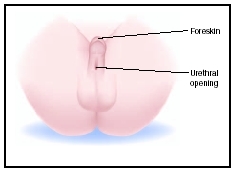Hypospadias
Definition
Hypospadias is a congenital defect of the penis in which the urinary tract opening, or urethral meatus, is abnormally located away from the tip of the penis.
Description
In males with hypospadias, the urinary opening is located on the underside of the penis. Often there is an accompanying underdevelopment of the foreskin in which the penis has a hooded appearance. Most of the foreskin is located on the top and sides of the tip of the penis. The urethral meatus may be located at any point along the penile shaft from just below the tip of the penis to closer to the body and/or near the scrotum. It may appear as a small hole in the penis or, in more severe cases, may be a longer slit-like opening. Some cases may involve chordee, a condition in which the penis bends down or away from the body during erection.
Demographics
Hypospadias is the most common anomaly of the penis affecting approximately one in 250 males born. Research has shown a doubling of the number of babies born with this anomaly. The reason for this increase is as of 2004 unknown.
Causes and symptoms
Hypospadias is a congenital anomaly resulting from incomplete closure of the tissue of the penis that forms the urethra (the tube that carries urine from the bladder to the outside of the body). The potential symptoms of hypospadias if left untreated include an abnormal direction of the urine stream, abnormal appearance of the penis, infertility if the defect is located far enough away from the tip of the penis, and an inability to have sexual intercourse in cases involving chordee.
Diagnosis
Hypospadias is diagnosed most often during the initial newborn physical examination and is classified based on where the urethral meatus is located. In rare cases infants with hypospadias occurring closer to the body and who also have undescended testicles, a karyotype or genetic screen may be performed to determine gender. Males who have hypospadias located within or near the scrotum should also have a procedure called a voiding cystogram to rule out additional urinary tract anomalies. In general, very few babies with hypospadias have other birth defects. Many males with multiple congenital anomalies, however, may also have hypospadias.
Prognosis
The prognosis for boys who have undergone hypospadias repair is excellent. Very few children experience complications. In most cases, the penis appears normal and functions normally. Less than 5 percent of children with mild hypospadias experience postoperative complications. Complications include wound infections, unexpected opening near the repair site, and rarely, meatul stenosis, a narrowing of the urinary tract opening.
Prevention
There was as of 2004 no known prevention of hypospadias.
Parental concerns
Most hypospadias cases are minor and involve few complications. Initially, parents should be sure their son is not circumcised because the foreskin is often essential in hypospadias repair surgery. Should the parents decide to allow corrective surgery, they should find a pediatric urologic surgeon with experience in performing hypospadias repairs. After surgery, care must be taken to follow all postoperative instructions and to obtain follow-up care from both the pediatrician and pediatric urologist. Parents may be concerned about the appearance and function of the penis. In most cases, following hypospadias repair surgery, the penis functions normally and is normal in appearance as well. Most males who have had a hypospadias repair are able to stand to urinate, experience normal sexual function, and normal fertility. Parents may be concerned about the physical and emotional pain of genital surgery. The recommended age of surgical repair is between four and 12 months. This age is ideal for many reasons including the size of the penis and the slow rate of growth of the penis at this age, the relatively low risk from anesthesia, and the fact that children at this age have not formed long-term memory and will not remember the surgery.
KEY TERMS
Anesthesia —Treatment with medicine that causes a loss of feeling, especially pain. Local anesthesia numbs only part of the body; general anesthesia causes loss of consciousness.
Chordee —An abnormal curvature of the penis.
Circumcision —A surgical procedure, usually with religious or cultural significance, where the prepuce or skin covering the tip of the penis on a boy, or the clitoris on a girl, is cut away.
Congenital —Present at birth.
Foreskin —A covering fold of skin over the tip of the penis.
Karyotype —A standard arrangement of photographic or computer-generated images of chromosome pairs from a cell in ascending numerical order, from largest to smallest.
Scrotum —The external pouch containing the male reproductive glands (testes) and part of the spermatic cord.
Urethra —A passageway from the bladder to the outside of the body for the discharge of urine. In the female this tube lies between the vagina and clitoris; in the male the urethra travels through the penis and opens at the tip. In males, seminal fluid and sperm also pass through the urethra.
Urethral meatus —The opening of the urethra on the body surface through which urine is discharged.
Voiding cystogram —A radiographic image of the mechanics of urination.
Resources
BOOKS
Berhman, Richard E., et al., eds. Nelson Textbook of Pediatrics , 16th ed. Philadelphia: Saunders, 2000.
Rudolph, Colin D., and Abraham M. Rudolph, eds. Rudolph's Pediatrics , 21st ed. New York: McGraw-Hill, 2003.
WEB SITES
"Hypospadias." Children's Hospital Boston , 2001. Available online at http://www.childrenshospital.org/cfapps/A2ZtopicDisplay.cfm?Topic=Hypospadias (accessed December 11, 2004).
"Hypospadias." Digital Urology Journal. Available online at http://www.duj.com/hypospadias.html (accessed December 11, 2004).
Deborah L. Nurmi, MS

Comment about this article, ask questions, or add new information about this topic: